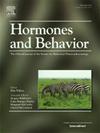长期的社会隔离、拥挤和不稳定明显影响成年雌性Wistar大鼠的生殖功能
IF 2.4
3区 医学
Q2 BEHAVIORAL SCIENCES
引用次数: 0
摘要
社会压力源代表高度相关的压力模型,在女性中仍未得到充分研究。同样,尽管下丘脑-垂体-肾上腺(HPA)轴和下丘脑-垂体-性腺(HPG)轴之间存在密切的相互作用,但人们对不同类型的社会压力对女性生殖功能的影响知之甚少。本研究对三种社会应激模式对雌性大鼠生殖功能的影响进行了全面评估。将112只定期循环的成年雌性Wistar大鼠暴露于21天的隔离、拥挤、社会不稳定、控制住房(每日更换笼子)或常规住房中。然后对大鼠实施安乐死(在发情前期或发情后期)或进行节奏交配和生育评估。评估发情周期、子宫角重量、下丘脑接吻素(Kiss1)、促性腺激素抑制激素(GnIH)、雌激素受体α (ERα)和糖皮质激素受体(GR)的表达、血清黄体生成素(LH)、促卵泡激素(FSH)、雌二醇(E2)、黄体酮(P4)、皮质酮(CORT)以及卵巢卵泡计数。研究结果表明,分离可增加跳跃行为,降低早期卵泡计数,子宫重量和GnIH,并增加FSH水平。在拥挤的大鼠中,GnIH和ERα的表达减少,与发情天数减少和跳跃行为增加有关。不稳定后,大鼠表现为发情周期下降,子宫重量减少,卵巢储备减少,尽管下丘脑水平变化很小。除不稳定和拥挤外,有节奏的交配暴露增加了所有组的CORT。总的来说,社会压力源对生殖产生了不同的影响,突出了它们作为压力模型的相关性,以及更好地理解社会压力诱导的女性生殖功能障碍的重要性。本文章由计算机程序翻译,如有差异,请以英文原文为准。
Chronic social isolation, crowding, and instability distinctly impact reproductive function in adult female Wistar rats
Social stressors represent highly relevant stress models which remain understudied in females. Concordantly, little is known of the impact of different types of social stress on female reproductive functioning, despite close interactions between the hypothalamic-pituitary-adrenal (HPA) axis and hypothalamic-pituitary-gonadal (HPG) axis. This study provides a comprehensive assessment of reproductive functioning in female rats following exposure to three social stress paradigms. 112 regularly cycling adult female Wistar rats were exposed to 21 days of isolation, crowding, social instability, control housing (daily cage changes) or regular housing. Rats were then euthanized (in proestrus or diestrus) or underwent paced-mating and fertility assessments. Estrous cyclicity, uterine horn weight, hypothalamic expression of kisspeptin (Kiss1), gonadotropin-inhibitory hormone (GnIH), estrogen receptors alpha (ERα), and glucocorticoid receptors (GR), serum luteinizing hormone (LH), follicle-stimulating hormone (FSH), estradiol (E2), progesterone (P4), and corticosterone (CORT), as well as ovarian follicle counts were assessed. Findings show isolation to increase hopping behaviors, decrease early follicle counts, uterine weight, and GnIH, as well as increase FSH levels. In crowded rats, expression of GnIH and ERα were reduced, paralleled by fewer days spent in proestrus and increased hopping behaviors. Following instability, rats presented decreased estrous cyclicity, reduced uterine weight, and diminished ovarian reserve, despite minimal changes at the hypothalamic level. Paced mating exposure increased CORT in all groups except instability and crowding. Overall, social stressors presented distinct consequences on reproduction, highlighting their relevance as stress models and the importance of gaining a better understanding of social stress-induced reproductive dysfunction in females.
求助全文
通过发布文献求助,成功后即可免费获取论文全文。
去求助
来源期刊

Hormones and Behavior
医学-行为科学
CiteScore
6.70
自引率
8.60%
发文量
139
审稿时长
91 days
期刊介绍:
Hormones and Behavior publishes original research articles, reviews and special issues concerning hormone-brain-behavior relationships, broadly defined. The journal''s scope ranges from laboratory and field studies concerning neuroendocrine as well as endocrine mechanisms controlling the development or adult expression of behavior to studies concerning the environmental control and evolutionary significance of hormone-behavior relationships. The journal welcomes studies conducted on species ranging from invertebrates to mammals, including humans.
 求助内容:
求助内容: 应助结果提醒方式:
应助结果提醒方式:


